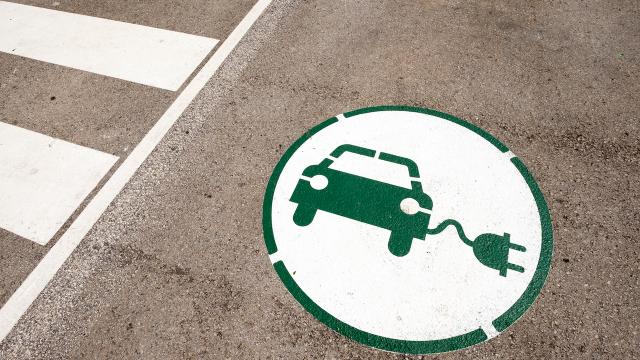
There’s a certain electricity in the air when it comes to electric vehicles. I’m sorry, that was terrible. Let’s try this again. Electric vehicles are quite the buzz right now. No no, we’re better than this. Let’s just say, electric vehicles are the way of the future — it seems it’s not a matter of if they will overtake our current gas-guzzling dinosaur mobiles in terms of widespread popularity, but when.
This rise in popularity is seeing a slew of new and exciting players entering the EV market, with manufacturers like Genesis shaking things up by proving EVs don’t need to sacrifice style.
That being said, currently, EVs still make up a small fraction of cars on the road. One reason being range anxiety — the fear one will run out of juice and be stranded far away from an EV charging station; not the most common sight on roads as society currently stands.
One potential solution to this current conundrum is roads that charge your car while you drive on them. No need to adjust your television folks, you heard that right. To explore how the hell this could actually work, and whether it’s really a feasible option, we sat down with Mathew Dickerson, a technologist, futurist, and host of the Tech Talk podcast.
Gizmodo: Roads that charge your car as you drive on them — that’s pretty cool. It feels very “sci-fi” — how far away are we from this being a reality?
Mathew: The future is here today — it is just not evenly distributed. We have become accustomed to charging our smartphones wirelessly. The Qi standard was created in 2008 and the first widely-available phone to adopt the Qi standard was the Nokia Lumia 920 in 2012. The technology goes back to 1894 when Nikola Tesla used resonant inductive coupling to light up lamps in New York City so the idea of transferring electricity wirelessly is not new. There are a number of sites across the world where demonstration facilities are already installed or are proposed.
In 2017, a 100m section of road in France had wireless charging installed that can charge at approximately 2km of additional battery charge per kilometre travelled on the road while travelling at 40km/h. Vehicles can travel up to 100km/h on that road.
In 2018, a 2km section of road in Sweden had electric rails installed. A special device could be fitted to your electric car similar to a Scalextric toy and it would drop in to the groove and charge the car while driving on it.
In 2020 in Israel, a 600m section of road was installed with wireless charging capabilities as a test in real-world conditions and if all the tests are successful, the proposal is to build the technology into an 18km long busway between a city and an airport.
In June this year, a dedicated 1.05km circuit was built in Italy to demonstrate Dynamic Wireless Power Transfer with a car and bus fitted with receivers driving at highway speeds around the circuit. This will charge at the rate of 1.5km per kilometre of roadway when travelling at 40km/h.
Operational in 2023 will be a 1.6km stretch of road in Detroit in the US that will be modified so that cars with a special receiver fitted to the underside will be allowed to charge while they drive on the road.
So looks like this is very much not just a concept, but a thing that’s actually being tried and tested. So where did the idea come from? How long have there been discussions of car-charging roads?
The idea originally came from a combination of wireless charging on smartphones and the range anxiety that people experience with electric vehicles. Instead of being anxious about the range of an electric vehicle, innovators thought that a better solution would be the ability to drive forever and never worry about charging your car.
OK, now tell me how it all works, keep in mind I am a simple guy.
In very simple terms, electricity is used to create an electromagnetic field. By placing a second coil within that electromagnetic field, electricity can be produced in the secondary coil. It is the same concept that is used in transformers and in wireless charging with mobile telephones.
Will it cost the consumer anything? Sucking energy from the ground for free sounds too good to be true.
Electric vehicles do not come standard with a receiver for wireless charging. For an electric vehicle to work with a wireless charging road, a receiver would firstly need to be installed on the underside of the car. In the initial ‘proofing’ stage of the technology, the cost of electricity may well be free but eventually, the technology would require an account to pay for the electricity used in the system as you drive on it. The system would recognise your car and charge your account accordingly.
Do you envision a future where these roads replace charging stations, or work in tandem with them?
There is certainly a place for both charging stations and charging roads. Charging roads don’t have to be limited to roads that you drive on — they would also be useful in locations such as taxi ranks. Taxi drivers could be charging their batteries every time they come back to a taxi rank and wait to collect their next passenger. The expense of installing a system in a roadway will limit the system to only certain roads, which is where charging stations will still have a role to play.
What impact will widespread adoption of this technology have on the world?
I have not stopped at a petrol station to fill up my car for over seven years but my memory of that experience is that it is an old-fashioned and clumsy concept that seems so wasteful of my time. My experience already is that charging at home while I sit inside enjoying my family or eating dinner is much better than wasting time at a petrol station. Even stopping at a charging station and having a break from driving while I buy a coffee or eat a meal is more pleasant. Charging roads will enhance the experience even further and remove one more inconvenience from the driving world.
Will it spell the end for gas-guzzling cars?
Roads that charge cars will not spell the end of ICEVs (Internal combustion engine vehicles). EVs will spell the end of ICEVs. Full stop.
What’s the biggest obstacle to this speculative future becoming a reality?
The cost and the need. The cost to install induction charging in a road is approximately 1 million dollars per kilometre — in an existing road. The roads that would have this installed need to be carefully chosen with the best roads where traffic is slow moving — the slower the movement, the more charge a car can receive with less distance. When you calculate the cost and the logistics you then start to question the need. Is it simply better to put that money into more charging stations or more subsidies on EV purchases? It is fascinating technology but is it really needed?
I guess time will tell. Anything you’d like to add before I buzz off?
There are many barriers to the adoption of electric vehicles. The main barrier is outright ignorance. Many of the common myths touted by people who have separate agendas or who are simply misinformed push people away from electric vehicles. The lack of vision from our governments has previously not been helpful as well but we will see the transformation occur despite lack of action from our government. The future is electric but at the current rate, our future in Australia will be somewhat slower than many countries overseas.
“I guarantee an EV battery will last longer than any car’s without maintenance.”@GenesisMotorsAu pic.twitter.com/OX6FqodP2V
— Gizmodo Australia (@GizmodoAU) September 29, 2022
Enticed by what you’ve just read? Excited by the future? Check out the new range of Electrified Genesis — the GV60, Electrified GV70, Electrified GV80 — an eco-conscious EV that doesn’t skimp on luxury. Go on, own a piece of the future, today.
